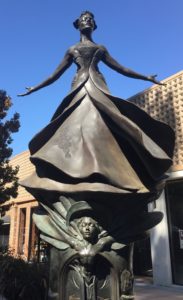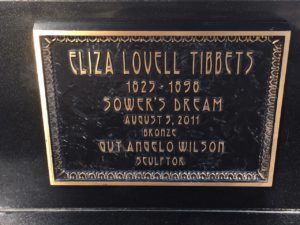




On a recent visit to Riverside, I stopped to get reacquainted with the fabulous Eliza Tibbets sculpture. It is located in the downtown pedestrian area around the corner from the Mission Inn Hotel (which is worth a visit or overnight stay if you’re in the area). The statue, created by Guy A. Wilson, was unveiled in 2011 and is the first statue in Riverside dedicated to a woman.

Before coming to California, Eliza Tibbets was a spiritualist, abolitionist and activist. But what is most remarkable about her story is her contribution to the citrus industry in California. She and her husband moved to Riverside in 1873, and she brought with her two small navel orange trees given to her by the US Department of Agriculture. The two trees, which originated in Brazil, took well to Riverside’s arid climate and produced a sweet seedless navel orange. So started Eliza Tibbet’s journey as the navel orange matriarch of Riverside.
The “Riverside Navel” became so popular that her parent navel trees eventually propagated California’s entire naval orange industry. The success of her orange trees inspired irrigation projects which converted more of the desert to orange groves. The size, scale, and ingenuity of the irrigation structures in Riverside and surrounding area are considered one of the agricultural marvels of the age. By 1893, Riverside was the wealthiest city per capita in the United States and new cities and towns sprung up around it.
An important participant in California’s citrus industry is UC Riverside. UCR started as a Citrus Experiment Station. It’s “Citrus Variety Collection” is among the most extensive of its kind in the world. UCR has been vital in fighting citrus diseases. Today, the campus has expanded to 20,000 students and plays a major role within Inland Southern California’s economy.
If you are a citrus fan, plan a visit to the California Citrus State Historic Park in Riverside. You’ll tour orchards of citrus trees, learn about grafting, and hear all about the history of California’s citrus industry. Best of all, at the end of the tour you can sample fresh fruit off the tree.
To think, it all began with two, seemingly inconspicuous navel orange trees planted in a Riverside garden by Eliza Lovell Tibbets.
